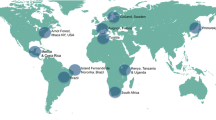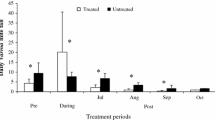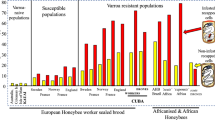Abstract
We document the ability of a population of honey bee colonies to survive in France without Varroa suppression measures. We compared the mortality of collected Varroa surviving bee (VSB) stock with that of miticide-treated Varroa-susceptible colonies. Varroa infestation did not induce mortality in the VSB colonies. Some of the original colonies survived more than 11 years without treatment and the average survival of the experimental colonies was 6.54 ± 0.25 years. Swarming was variable (41.50 ± 9.94%) depending on the year. Honey production was significantly higher (1.7 times) in treated than in VSB colonies. For the first time since Varroa invaded France, our results provide evidence that untreated local honey bee colonies can survive the mite, which may be the basis for integrated Varroa management.
Zusammenfassung
Die Überlebensdauer von mit Varroa destructor befallenen Apis mellifera Völkern ohne Behandlung wurde bisher auf ein oder zwei Jahre geschätzt. 1994 wurden an zwei verschiedenen Standorten 12 Honigbienenvölker gefunden, die ohne Behandlung gegen Varroa überlebt hatten. Wir stellten zusätzliche potentiell resistente Bienenvölker von Imkern zusammen und verstärkten diese Gruppe damit. In der vorliegenden Arbeit berichten wir über die Fähigkeit dieser Bienen in Frankreich, ohne jede Form der Varroabehandlung zu überleben. Wir verglichen die Sterblichkeit unserer Versuchsgruppe mit Kontrollvölkern, die mit Akariziden behandelt wurden. Außer monatlichen Beobachtungen, dem Zufügen von Magazinen und der Ernte des Honigs, wurden die Völker nicht bewirtschaftet, es fand auch keine Schwarmkontrolle statt. Die Honigernte wurde für jedes Volk bestimmt und mit der der Kontrollvölker verglichen.
Die Sterblichkeit der Völker mit varroaüberlebenden Bienen (VSB) schwankte in der Zeit zwischen 1999 und 2005 zwischen 9,7 % und 16,8 % pro Jahr. Fünf der 12 Originalvölker überlebten mehr als 11 Jahre ohne Behandlung, die Überlebensdauer in dieser Gruppe betrug im Schnitt 9,8 ± 0,7 (Mittelwert und Standardabweichung) je nach Jahr, und wir fanden keine signifikanten Unterschiede zwischen der Sterblichkeit der VSB (12,46 ± 0,92) und der behandelten Kontrollvölker (9,57 ± 1,59). Die Schwarmtätigkeit war in den verschiedenen Jahren sehr variabel (Mittelwert und Standardabweichung: 41,50 ± 9,94 %) und konnte das unterschiedliche Überleben der Völker nicht erklären. Die Honigproduktion der gegen Varroa behandelten Kontrollgruppe war gegenüber den VSB Völkern um einen Faktor von 1,7 signifikant erhöht.
Unsere Ergebnisse zeigen klar, dass einige Honigbienenvölker auch ohne Schutzmaßnahmen gegen Varroa wesentlich längere Zeiten überleben können als dies zuvor angenommen worden war. Der Befall mit Varroa verursachte während der 9jährigen Untersuchungszeit bei den VSB Völkern keinen signifikanten Tod. Wir diskutieren verschiedene Hypothesen, die das Phänomen erklären könnten. Es ist naheliegend anzunehmen, dass die Resistenz der Bienenvölker, aber auch die Virulenz von Varroa und das Vorkommen von Virusinfektionen unter beständigem Selektionsdruck auf das Überleben von beiden, dem Wirt und dem Parasiten, stehen. Das erste Mal seit der Einwanderung von Varroa nach Frankreich zeigen unsere Ergebnisse die Fähigkeit unbehandelter lokaler Honigbienen den Befall mit den Milben zu überleben. Diese Bienen könnten im Rahmen des integrierten Bienenmanagements in Frankreich von hohem Nutzen werden.
Similar content being viewed by others
References
Branco M.R., Kidd N.A.C., Pickard R.S. (1999) Development of Varroa jacobsoni in colonies of Apis mellifera iberica in a Mediterranean climate, Apidologie 30, 491–503.
De Jong D., Soares A.E.E. (1997) An isolated population of Italian bees that has survived Varroa jacobsoni infestation without treatment for over 12 years, Am. Bee J. 137, 742–745.
Eguaras M., Marangeli J., Oppedisano M., Fernandez N. (1995) Mortality and reproduction of Varroa destructor in resistant colonies of honey bees (Apis mellifera) in Argentina, Bee Science 174–178.
Fries I., Camazine S., Sneyd J. (1994) Population Dynamics of Varroa jacobsoni — A Model and a Review, Bee World 75, 5–28.
Fries I., Hansen H., Imdorf A., Rosenkranz P. (2003) Swarming in honey bees (Apis mellifera) and Varroa destructor population development in Sweden, Apidologie 34, 389–397.
Fries I., Imdorf A., Rosenkranz P. (2006) Survival of mite infested (Varroa destructor) honey bee (Apis mellifera) colonies in a Nordic climate, Apidologie 37, 564–570.
Guzman-Novoa E., Vandame R., Arechavaleta M.E. (1999) Susceptibility of European and Africanized honey bees (Apis mellifera L.) to Varroa jacobsoni Oud. in Mexico, Apidologie 30, 173–182.
Jéanne F., Jéanne B., Bartlet R., Le Conte Y., Vallon J., Mazet I., de Vaublanc G. (2002) Survie d’abeilles à Varroa, Bull. Tech. Apic. Opida 29, 73–78.
Kefuss J., Vanpoucke J., De Lahitte J.D., Ritter W. (2004) Varroa tolerance in France of intermissa bees from Tunisia and their naturally mated descendants: 1993–2004, Am. Bee J. 144, 563–568.
Korpela S., Aarhus A., Fries I., Hansen H. (1992) Varroa jacobsoni Oud in Cold Climates — Population Growth, Winter Mortality and Influence on the Survival of Honey Bee Colonies, J. Apic. Res. 31, 157–164.
Le Conte Y., Bocquet M., Jeanne F. (2000) Résultat de l’Enquête sur la tolérance éventuelle des colonies à Varroa, Bull. Tech. Apic. Opida 135–137.
Martin C., Provost E., Roux M., Bruchou C., Crauser D., Clement J.L., Le Conte Y. (2001) Resistance of the honey bee, Apis mellifera to the acarian parasite Varroa destructor: behavioural and electroantennographic data, Physiol. Entomol. 26, 362–370.
Martin S.J., Medina L.M. (2004) Africanized honeybees have unique tolerance to Varroa mites, Trends Parasital. 20, 112–114.
Moretto G., Mello L.J. (2000) Resistance of Africanized bees (Apis mellifera L.) as a cause of mortality of the mite Varroa jacobsoni Oud. in Brazil, Am. Bee J. 140, 895–897.
Navajas M., Le Conte Y., Solignac M., Cros-Arteil S., Cornuet J.M. (2002) The complete sequence of the mitochondrial genome of the honeybee ectoparasite mite Varroa destructor (Acari: Mesostigmata), Mol. Biol. Evol. 19, 2313–2317.
Peng Y.S., Fang Y., Xu S., Ge L. (1987) The resistance mecanism of the Asian Honey Bee, Apis cerana Fabr., to an Ectoparasitic Mite, Varroa jacobsoni Oudemans, J. Invertebr. Pathol. 49, 54–60.
Robaux P. (1986) Varroa et la Varroatose, Opida, Echauffour.
Rinderer T.E., deGuzman L.I., Delatte G.T., Stelzer J.A., Lancaster V.A., Kuznetsov V., Beaman L. (2001) Resistance to the parasitic mite Varroa destructor in honey bees from far-eastern Russia, Apidologie 32, 381–394.
Ritter W. (1981) Varroa disease of the honey bee Apis mellifera, Bee World 62, 141–153.
Ritter W. (1990) Development of varroa mite population in treated and untreated colonies in Tunisia, Apidologie 21, 368–370.
Ritter W., de Jong D. (1984) Reproduction of Varroa jacobsoni in Europe, the Middle East and tropical South America. Z. Angew. Entomol. 98, 55–57.
Rosenkranz P. (1999) Honey bee (Apis mellifera L.) tolerance to Varroa jacobsoni Oud. in South America, Apidologie 30, 159–172.
Ruttner F., Marx H., Marx G. (1984) Beobachtungen über eine mögliche Anpassung von Varroa jacobsoni an Apis mellifera L. in Uruguay, Apidologie 15, 43–62.
Seeley Th. (2006) Honey bees of the Arnot Forest: a population of feral colonies persisting with Varroa destructor in the northeastern United States, Apidologie 38, 19–29.
Solignac M., Vautrin D., Pizzo A., Navajas M., Le Conte Y., Cornuet J.M. (2003) Characterization of microsatellite markers for the apicultural pest Varroa destructor (Acari: Varroidae) and its relatives, Mol. Ecol. Notes 3, 556–559.
Solignac M., Cornuet J.M., Vautrin D., Le Conte Y., Anderson D., Evans J., Cros-Arteil S., Navajas M. (2005) The invasive Korea and Japan types of Varroa destructor, ectoparasitic mites of the Western honey bee (Apis mellifera), are two partly isolated clones, Proc. R. Soc. Lond. Ser. B-Biol. Sci. 272, 411–419.
Vandame R., Colin M.E., Morand S., Otero-Colina G. (2000) Levels of compatibility in a new hostparasite association: Apis mellifera/Varroa jacobsoni, Can. J. Zool. 78, 2037–2044.
Author information
Authors and Affiliations
Corresponding author
Additional information
Manuscript editor: Stefan Fuchs
Rights and permissions
About this article
Cite this article
Le Conte, Y., de Vaublanc, G., Crauser, D. et al. Honey bee colonies that have survived Varroa destructor . Apidologie 38, 566–572 (2007). https://doi.org/10.1051/apido:2007040
Received:
Revised:
Accepted:
Issue Date:
DOI: https://doi.org/10.1051/apido:2007040




